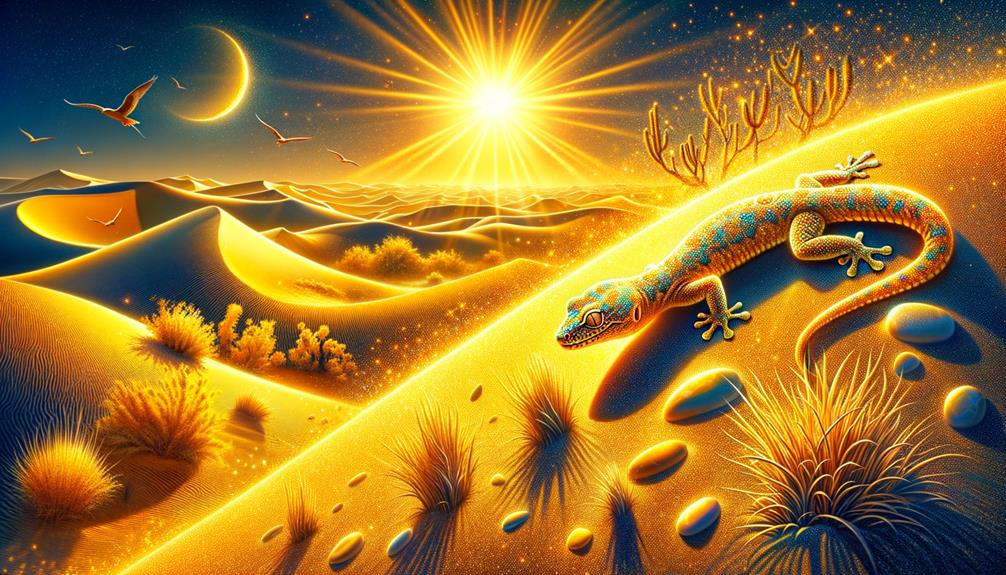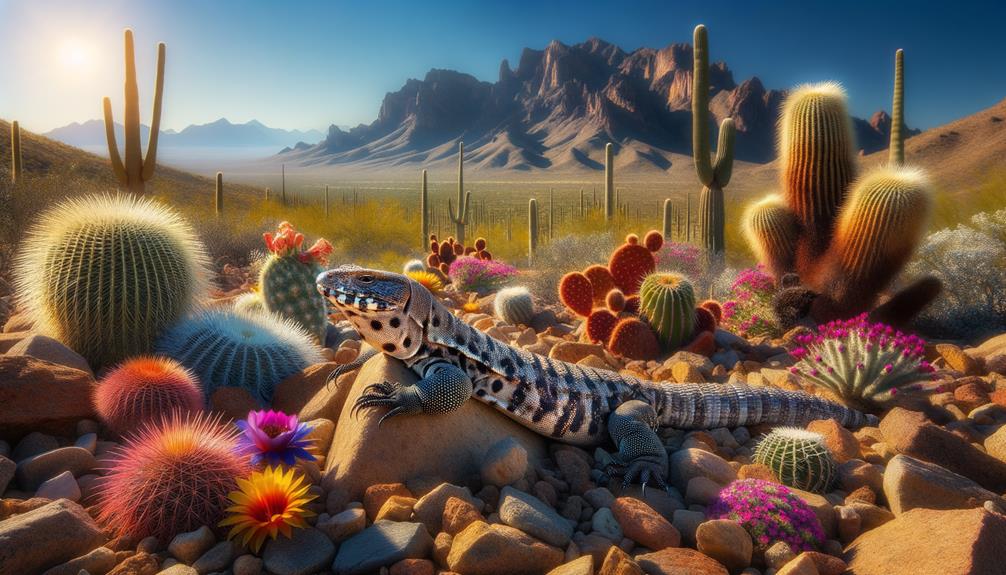When I venture into the Mojave Desert under the cover of darkness, I’m captivated by the secretive lives that unfold. Desert night lizards, with their earthy camouflage, slip silently beneath the shadows of Joshua Trees and shrubs. I catch a glimpse of a rosy boa gliding effortlessly over rocky terrain, while Mojave rattlesnakes employ their heat-sensing pits to stalk warm-blooded prey. These creatures have evolved remarkable adaptations to thrive in this harsh environment, from their water-conserving scales to their nocturnal habits that sidestep the scorching daytime heat. Drawn by the promise of cool darkness, they navigate this unforgiving landscape with remarkable agility. Each new discovery adds depth to the intricate tapestry of desert life waiting to be uncovered.
Key Takeaways
The Mojave Desert is home to a diverse range of nocturnal reptiles, including desert night lizards, rosy boas, and Mojave rattlesnakes. These creatures have adapted to the harsh desert environment in unique ways. For instance, desert night lizards find shelter and camouflage in microhabitats under Joshua tree bark and yucca plants. The granular scales and nocturnal behavior of these reptiles help minimize water loss and regulate their body temperature. Mojave rattlesnakes, in particular, have developed infrared-sensitive pits that enable them to detect warm-blooded prey during nighttime. To protect these fascinating creatures, conservation efforts focus on preserving habitats, conducting ecological research, and educating the public about the importance of preserving the Mojave’s nocturnal reptiles.
Common Species
While exploring the Mojave Desert’s nocturnal landscape, I often stumble upon a fascinating array of reptile species, each uniquely adapted to thrive in this harsh environment. Among the most intriguing is the desert night lizard, scientifically known as Xantusia vigilis. This small, brown lizard is a master of stealth and often hides under the protective cover of Joshua tree bark and desert shrubbery. As I tread softly under the starry sky, I notice how this species blends seamlessly into its surroundings, evading predators and seeking out insects with remarkable precision.
The desert night lizard isn’t alone in this nocturnal world. Other reptile species, like gentle rosy boas and formidable Mojave rattlesnakes, traverse the desert floor. Each night, I witness these creatures navigating the cool desert sands, their adaptations a testament to survival in one of North America’s most extreme environments. The desert night lizard’s secretive nature and the nightly symphony of reptilian movements remind me of the delicate balance within this ecosystem. These species, from the north to the southern reaches of the Mojave, illustrate the remarkable resilience and diversity of desert life.
Habitat Preferences
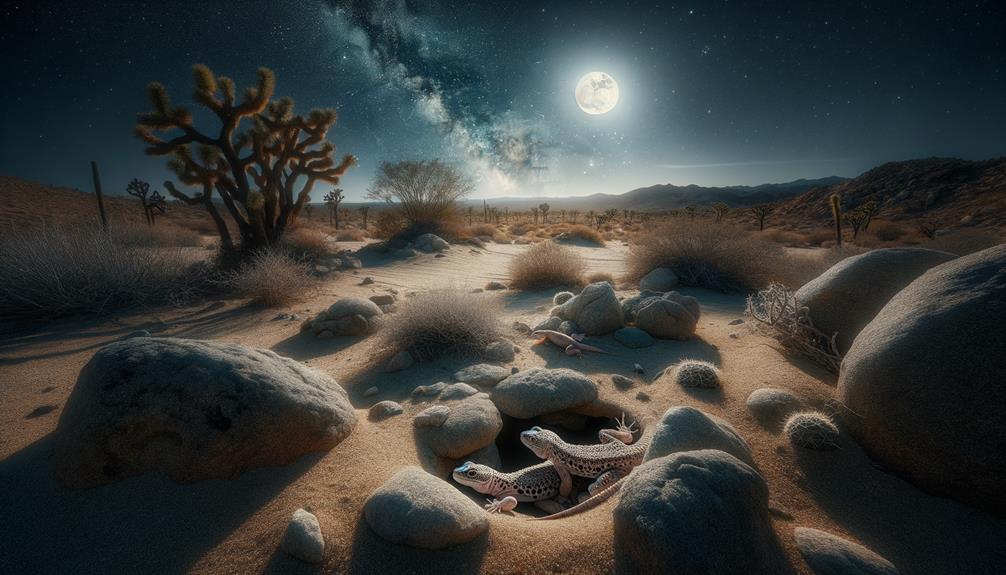
As I venture deeper into the Mojave Desert at night, I often find that desert night lizards are drawn to areas with abundant fallen Joshua Tree branches and yucca plants, which offer the dark, sheltered microhabitats they need to thrive. These elusive creatures, known scientifically as Xantusia vigilis, are masters of blending into their surroundings. Under the bark of decaying Joshua Trees and nestled within the protective embrace of yucca plants, they find refuge from predators and the harsh desert environment.
The Mojave’s arid and semi-arid landscapes provide the perfect setting for these nocturnal reptiles. Fallen vegetation and rock crevices are essential components of their habitat. As I carefully lift a piece of bark or peek into a rocky crevice, I might catch a glimpse of one of these secretive lizards. Their preference for such specific cover types highlights the importance of these natural structures in their survival.
Exploring the desert at night, I’m reminded that the availability of suitable cover is crucial for desert night lizards. The intricate balance of fallen vegetation and rock crevices creates a hidden world where these remarkable reptiles can flourish.
Unique Adaptations
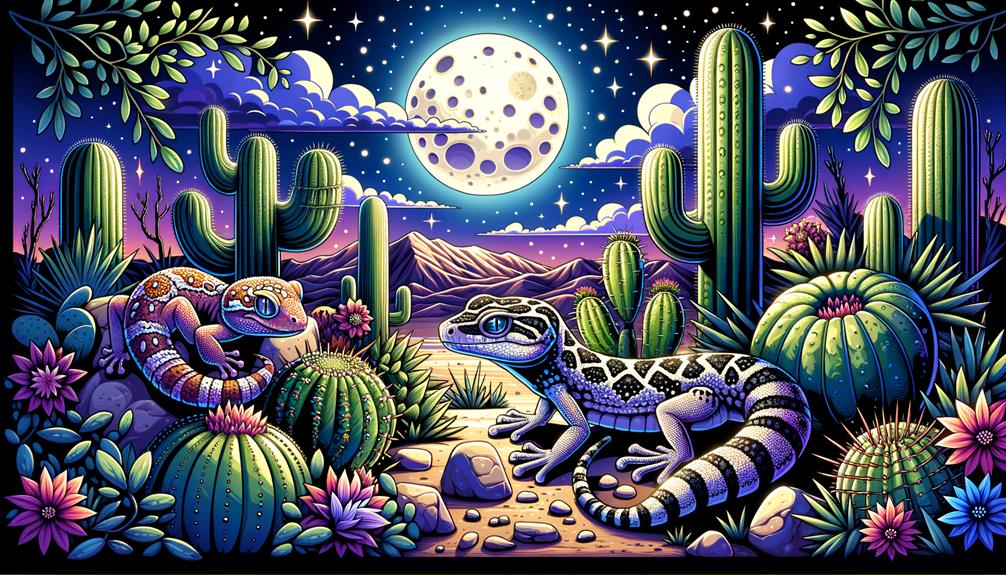
Venturing into the Mojave Desert’s nocturnal world, I’m struck by the array of unique adaptations that reptiles have evolved to survive in this unforgiving environment. The Desert Night Lizard, belonging to the Genus Xantusia, exemplifies this with its granular scales that minimize water loss and aid in thermoregulation. These nocturnal creatures have evolved to thrive in the arid and semi-arid conditions of the Mojave Desert.
Imagine these remarkable adaptations:
- Granular scales: Reducing water loss is crucial in an arid environment, and these scales do just that.
- Camouflage: Blending seamlessly with the desert landscape helps them evade predators.
- Thermoregulation: By being nocturnal, they avoid the extreme daytime heat, effectively managing their body temperature.
- Diverse shelters: From burrows to crevices, these lizards utilize diverse habitats to stay cool and conserve moisture.
- Quick reflexes: Essential for escaping predators and capturing prey in the dark.
The Desert Night Lizard’s ability to adapt to such a harsh environment demonstrates the resilience and ingenuity of life. These adaptations are not just survival mechanisms; they are a testament to the incredible diversity and complexity of life in the Mojave Desert.
Behavior Patterns
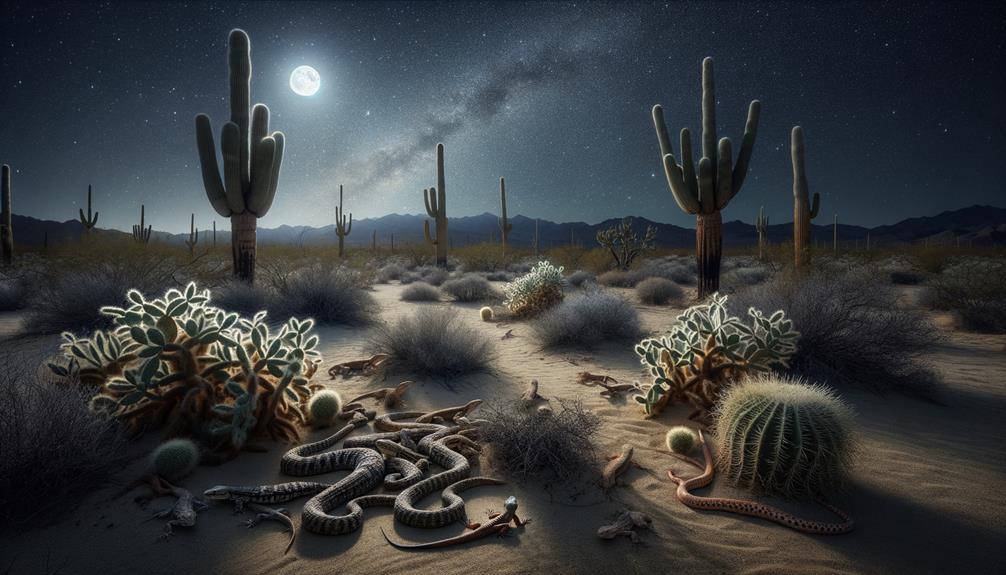
Observing the behavior patterns of Mojave Desert reptiles, I’m struck by how their nocturnal and crepuscular habits enable them to navigate and thrive in the harsh desert environment. As the sun dips below the horizon, these creatures emerge from their daytime hideaways. The desert night lizard, naturally elusive, spends most of its time hiding under fallen yucca and Joshua tree branches. It’s only occasionally spotted darting across the desert floor, its enlarged eyes perfectly adapted for low-light conditions.
The chuckwalla and desert tortoise exhibit distinct behavior patterns. While they are generally more active during the day, they retreat to shaded crevices or burrows to escape the scorching midday heat. The desert tortoise, for instance, can often be seen basking in the early morning sun before seeking shelter.
Many nocturnal reptiles, like the Mojave rattlesnake, have developed specialized senses, such as infrared-sensitive pits, to detect warm-blooded prey in the dark. When threatened, these reptiles display a fascinating array of defensive behaviors. Some will hiss or whip their tails, while others, like certain lizards, can detach their tails to evade predators. Each behavior is a testament to their resilience and adaptability in this unforgiving landscape.
Conservation Efforts
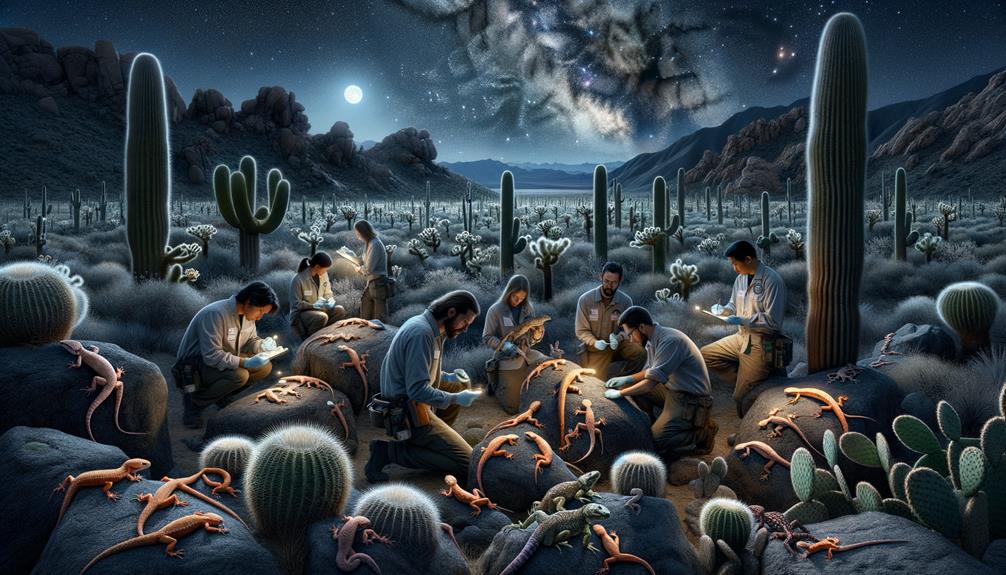
Conservation efforts for Mojave Desert nocturnal reptiles rely on a mix of scientific research, habitat preservation, and public awareness to ensure these resilient creatures continue to thrive in their unique ecosystem. Through ongoing monitoring, we strive to better understand the population trends and ecological needs of species like the Desert Night Lizard, Xantusia vigilis.
To clarify our strategies:
Habitat preservation: We restore and protect critical habitats, securing safe, undisturbed environments for nocturnal reptiles.
Ecological research: By studying these species, we gain valuable insights into their behaviors and interactions within the Mojave Desert.
Raising awareness: We educate the public about the significance of these reptiles, highlighting the need to minimize human disturbance.
Recreational impact management: Managing recreational activities, such as off-road vehicle use, helps mitigate damage to sensitive habitats.
Collaborative conservation: Government agencies, conservation organizations, and local communities work together to implement long-term conservation strategies.
These concerted efforts are crucial for the survival of these nocturnal reptiles. By prioritizing public education, we can foster a culture of respect and care for the Mojave Desert’s delicate ecosystem. By combining scientific rigor with community involvement, we ensure species like the Desert Night Lizard continue to thrive for future generations.
Frequently Asked Questions
What Kind of Lizards Live in the Mojave Desert?
In the Mojave Desert, I’ve encountered a fascinating array of lizards. The desert night lizard seeks refuge under Joshua trees, while the chuckwalla puffs up in rock crevices. The zebra-tailed lizard flashes its striking striped tail, and the side-blotched lizard darts about with impressive speed. Each of these creatures is a remarkable aspect of the Mojave Desert’s unique biodiversity.
Does the Mojave Desert Have Snakes?
The Mojave Desert is home to a diverse range of snakes. I’ve had encounters with venomous species like the Mojave rattlesnake and coral snake, as well as non-venomous ones like the gopher snake. Each encounter is a thrilling experience that showcases the desert’s wild beauty.
Do Komodo Dragons Live in the Mojave Desert?
Komodo dragons aren’t found in the Mojave Desert. Their natural habitat is in Indonesia, where they thrive on a few islands. Meanwhile, the Mojave Desert has its own unique reptiles that have adapted perfectly to the harsh environment.
Are There Any Nocturnal Reptiles?
I’ve had the opportunity to observe nocturnal reptiles thriving in the darkness. Geckos and rattlesnakes are perfect examples, showcasing their adaptability and survival instincts as they roam freely in the desert landscape under the cover of night.


